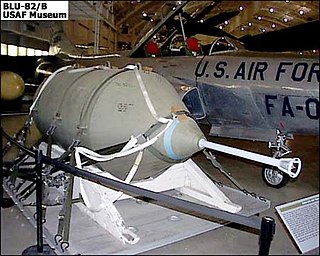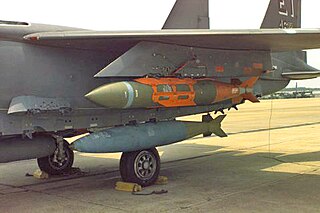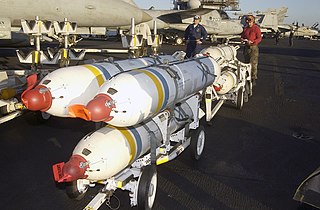 W
WThe BLU-82B/C-130 weapon system, known under program "Commando Vault" and nicknamed "Daisy Cutter" in Vietnam for its ability to flatten a section of forest into a helicopter landing zone, is an American 15,000-pound (6,800 kg) conventional bomb, delivered from either a C-130 or MC-130 transport aircraft or a CH-54 heavy-lift "SkyCrane" helicopter from the 1st Air Cavalry. A total of 225 were constructed. It was successfully used during military operations in Vietnam, the Gulf War and Afghanistan. The BLU-82 was retired in 2008 and replaced with the more powerful GBU-43/B MOAB.
 W
WThe BLU-109/B is a hardened penetration bomb used by the United States Air Force. As with other "bunker busters", it is intended to smash through concrete shelters and other hardened structures before exploding. In addition to the US, it is part of the armament of the air forces of Australia, Belgium, Canada, Denmark, France, Germany, Greece, Italy, Israel, Netherlands, Norway, Saudi Arabia, United Kingdom and United Arab Emirates.
 W
WThe CBU-24 is an unguided, aircraft delivered anti-personnel and anti-materiel weapon developed by the United States. Because it is an unguided weapon, the CBU-24 can be carried and dropped by any aircraft capable of carrying standard "dumb" or "iron" bombs.
 W
WThe CBU-100 Cluster Bomb is an American cluster bomb which is employed primarily in an anti-tank mode. It weighs 222 kg and carries 247 Mk 118 Mod 1 bomblets.
 W
WThe M69 incendiary bomblet was used in air raids on Japan and China during World War II, including the firebombing of Tokyo in 1945. It was created by the Standard Oil Development Company, whose work was funded by the Office of Scientific Research and Development. They were nicknamed "Tokyo calling cards". The M69 was a plain steel pipe with a hexagonal cross section 3 inches (7.6 cm) in diameter and 20 inches (51 cm) long. It weighed about 6 pounds (2.7 kg).
 W
WThe M117 is an air-dropped demolition bomb used by United States military forces. The weapon dates back to the Korean War of the early 1950s. Although it has a nominal weight of 750 pounds (340 kg) its actual weight, depending on fuze and retardation options, can be around 820 pounds (372 kg). The bomb's explosive content is typically 386 pounds (175 kg) of Tritonal or 377 pounds (171 kg) of Minol in the case of the M117A1E2due to their higher density and detonation velocity compared to TNT. Demolition bombs rely on time delayed fuzes which allow the bomb to burrow into a building or other structure before detonating. The M117 can be configured with a conical low-drag tail for medium and high altitude deliveries or a high-drag tail fin for low-altitude drops, delaying the bombs hitting their targets ensuring fighters are out of the blast zone before detonation.
 W
WThe Mark 77 bomb (MK-77) is a United States 750-pound (340 kg) air-dropped incendiary bomb carrying 110 U.S. gallons of a fuel gel mix which is the direct successor to napalm.
 W
WThe Mark 83 is part of the Mark 80 series of low-drag general-purpose bombs in United States service.
 W
WThe PDU-5/B is an aircraft-deployed leaflet dispersal unit. It is derived from the CBU-100 "Rockeye" Cluster Bomb, developed by the U.S. Air Force around 1999. It was used successfully in Afghanistan and Iraq to distribute leaflets. In 2015, it was used again to drop 60,000 leaflets near Raqqa, Syria.